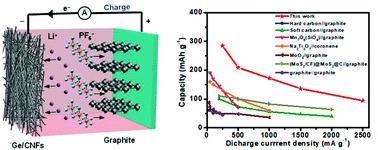Germanium-based high-performance dual-ion batteries†
Abstract
Recently, dual-ion batteries (DIBs) have received immense attention owing to their high operating voltage and low cost, and further studies on the enhancement of their energy densities and cyclabilities are being intensively pursued. Herein, a novel Ge-based DIB has been developed for the first time by using a rationally designed nanocomposite of Ge particles embedded in one-dimensional carbon nanofibers (Ge/CNFs) as an anode. The resulting battery shows a high discharge capacity of 281 mA h g−1 at a discharge current of 0.25 A g−1 and a superb rate capability of 94 mA h g−1 at a discharge current of 2.5 A g−1, which greatly surpasses those of most of the reported DIBs. These remarkable properties can be ascribed to the fact that the uniform one-dimensional nanostructure facilitates the improvement of lithium-ion diffusion within the hybrids, and the carbon matrix effectively alleviates the volume expansion of Ge during the cycling process and simultaneously enhances the electrical conductivity of the hybrids. The charge storage mechanism of Ge/CNFs is found to be Ge alloying with Li, accompanied by a phase transformation process from crystalline Ge to amorphous LixGe alloys. This work paves the way for the rational utilization of Ge-based materials in new-generation high-performance DIBs.



 Please wait while we load your content...
Please wait while we load your content...